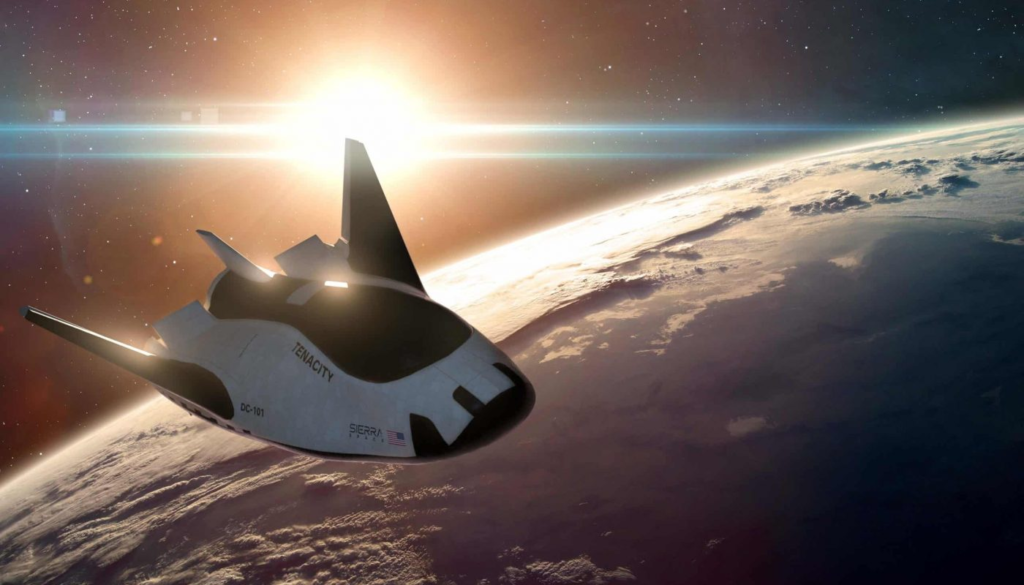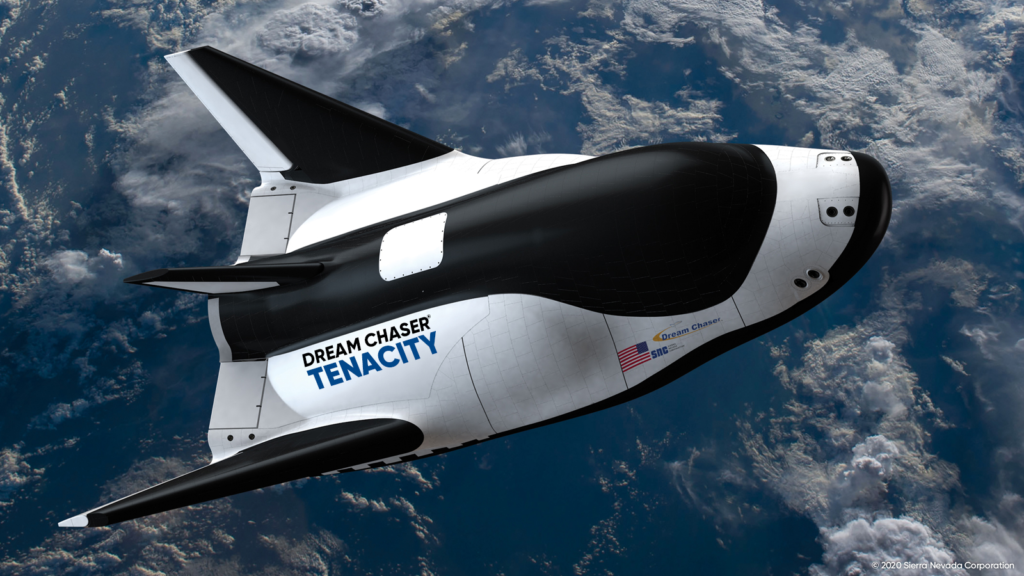
Dream Chaser Might Transport Cargo Around The World
The space industry is evolving at an extremely fast pace right before our eyes. A host of different companies are all working towards unique ways to access space. With this goal comes new and ambitious ideas along with new possibilities for both accessing and utilizing space. Sierra Space is one example with projects such as Dream Chaser, a reusable spaceplane with a promising future if successful.
In the last few months, the company has kept us updated on some of the test articles being worked on for future launches. However, in addition to this, they recently announced a possible future opportunity for Dream Chaser to transport cargo around the world. Specifically, they signed a Cooperative Research & Development Agreement with the U.S. government to explore future options.
This not only has to do with the Dream Chaser spaceplane itself but also the Shooting Star model and other spacecraft increasing the company’s capabilities. While this goal seems a bit ambitious even for these future spacecraft, it looks as if everyone involved is very serious about this future prospect. Here I will go more in-depth into the recent announcement, why they picked Dream Chaser, its impact on Sierra Space, and more.
Recent Agreement

Sierra Space has been busy as they work on not only Tencaity but also a new Dream Chaser test article they revealed not long ago. In addition, earlier this month they tweeted saying, “Sierra Space has signed a Cooperative Research & Development Agreement (CRADA) with @US_TRANSCOM to work together to develop solutions using Sierra Space’s Dream Chaser spaceplanes, Shooting Star cargo modules, and on-orbit infrastructure.” Specifically, on September 8th, they announced the signing of a CRADA with the United States Department of Defense’s Transportation Command (USTRANSCOM).
Apart of this agreement, the two organizations will work together to develop solutions using Sierra Space’s Dream Chaser® spaceplanes, Shooting Star™ cargo modules, and on-orbit infrastructure that provides unique capabilities for precise, cost-effective and timely global delivery of Department of Defense logistics and personnel. The goal is for both parties to collaboratively explore space transportation as a new mode of point-to-point global terrestrial delivery of materiel and personnel, as an alternative and complement to traditional air, land, and surface modes for Department of Defense global supply chains. Additionally, the agreement outlines plans to identify current capabilities and maturity of Sierra Space’s space transportation methods, as well as both observed and projected risks, benefits, and additional research and development needed as a result.
At the time of the agreement, CEO of Sierra Space, Tom Vice pointed out, “Today’s agreement with the United States Transportation Command gives Sierra Space the unique opportunity to provide hypersonic point-to-point solutions to our government customers. Through Dream Chaser, the world’s first commercial spaceplane, the Shooting Star cargo module, and other projects, we are focused on providing unique ultra-high-speed, heavy payload solutions to the Department of Defense for logistics and personnel movement requirements. We plan to leverage these technologies to reach anywhere on the globe within three hours.” One of the reasons an ambitious goal like this is even being considered is because of some serious concerns. They highlight the urgent pace of contested and changing environments and instantaneous sophisticated cyber threats that increasingly complicates the traditional distance-driven challenges of on-time worldwide logistics delivery. Considering this environment, this Sierra Space and USTRANSCOM agreement will develop concepts and investigate emerging industry capabilities for projection of forces for immediate employment, and agile transportation options to project and sustain combat forces in complex and contested environments in addition to non-combat activities such as humanitarian relief operations and medical missions.
As of right now, the main option for high speed transportation the government uses, relies on traditional aircraft. This often involves multiple stops, refueling, and more. While the prospect of Sierra Space’s Dream Chaser spaceplane moving cargo around the world is quite ambitious, it would most definitely improve the speed. It’s important to point out that this service would absolutely cost more, but it’s possible the government would be willing to pay a high price for certain cargo needed around the world as fast as possible. In addition to this, a very similar agreement was made with Rocket Lab around the same time. This makes it very clear the U.S. government is very serious about the future of point to point transportation and looking at a host of different upcoming options within the space industry.
Dream Chaser’s Future

Now that we know more about this new agreement, we can take a closer look at how realistic the future of this agreement is, along with some of the progress Dream Chaser has made. As of right now, Sierra Space is working on two different Dream Chaser test articles. This includes Dream Chaser Tenacity which has a significant amount of progress done and is not far away from being flight ready. There is also a new test article being worked on that the company revealed just weeks ago in late August. Depending on the future tests and success of the initial test articles, we could expect to see Dream Chaser in space not long from now. The official date for its initial uncrewed launch is 2023. Dream Chaser has two different variants including a crewed and uncrewed model. This agreement would utilize the uncrewed cargo variant which is expected to be flight ready much sooner than the crewed variant.
Specifically, under NASA’s Commercial Resupply Services 2 contract, Dream Chaser is set to provide a minimum of seven cargo service missions to and from the space station. With the help of the Shooting Star service module, Dream Chaser can deliver up to 5,500 kg of pressurized and unpressurized cargo to the space station, including food, water, supplies, and science experiments and returns to Earth. In addition, Dream Chaser can return critical cargo at less than 1.5 g’s using a gentle runway landing. Designed for high reusability, this vehicle is trying to reduce overall cost, providing quick turnarounds between missions. The ability to liftoff on top of multiple launch vehicles and land at a wide variety of runways makes Dream Chaser a flexible option for reliable transportation. After leaving the space station, the Dream Chaser Cargo System also offers disposal services via the Shooting Star transport vehicle. Once separated from Dream Chaser, Shooting Star burns up safely in Earth’s atmosphere. All of these features make this spacecraft, especially appealing to the government for transporting cargo.
Taking a closer look at the shooting star module, this is a flexible 15-foot transport vehicle that will be used as an attachment to the Dream Chaser spaceplane, but also has other applications such as a free-flying spacecraft. Shooting Star provides substantial payload storage in addition to the pressurized payloads carried in Dream Chaser. Its addition will help increase what’s capable for point to point transportation using this spacecraft.
In addition, the Dream Chaser spaceplane is a multi-mission vehicle capable of supporting a variety of LEO needs. It can be customized for both domestic and international customers via vehicle configuration, launch site, destination, landing site, duration, and a host of other variables. Sierra Space has entered into agreements with multiple international space agencies. Together they are working to develop technologies, applications, and missions for Dream Chaser-based space systems. All of which comes back to the recent agreement and if this would be viable for future transportation. One of the unique aspects of Dream Chaser that heavily benefits a future transporting cargo is runway landings. Earlier this year in June, Sierra Space announced the signing of a new Memorandum of Understanding. The agreement adds the world-class New Mexico spaceport to Sierra Space’s portfolio of potential global landing sites for its Dream Chaser. Spaceport America, located in southern New Mexico, is the most recent addition to a growing list of compatible runways worldwide where the Dream Chaser could land, including the Shuttle Landing Facility at NASA’s Kennedy Space Center, and airports and landing sites in Huntsville, Alabama, Oita Airport, Japan, and Spaceport Cornwall in the United Kingdom. As time goes on Sierra Space plans to continue growing this list and gaining access to more locations around the world. These opportunities are appealing when transporting cargo from one place on the planet to another.
Conclusion
Sierra Space recently announced an agreement with the U.S. government to look at a possible future of point to point transportation using Dream Chaser. While the company continues to make progress on its test articles, this agreement could be an ambitious future for the spacecraft. This being said, it would still be very expensive and include added risk. We will have to wait and see how it progresses and the impact it has on the space industry.
